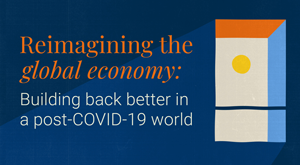This essay is part of “Reimagining the global economy: Building back better in a post-COVID-19 world,” a collection of 12 essays presenting new ideas to guide policies and shape debates in a post-COVID-19 world.
 Growth of labor productivity—output per worker—is the single most important source of lasting per capita income growth. Unfortunately, even before the onset of the COVID-19 pandemic, productivity growth had been slowing around the world (Figure 7.1).1 In advanced economies, the slowdown continues a trend that has been underway since the late 1990s. In the aftermath of the 2007-2009 global financial crisis, emerging market and developing economies (EMDEs) have experienced the steepest, longest, and most synchronized fall-off in productivity growth in decades. The COVID-19 pandemic could further reduce productivity growth and compound the adverse consequences stemming from the protracted slowdown in productivity. A proactive and comprehensive policy approach is needed to improve prospects for productivity and overcome the challenges associated with COVID-19.
Growth of labor productivity—output per worker—is the single most important source of lasting per capita income growth. Unfortunately, even before the onset of the COVID-19 pandemic, productivity growth had been slowing around the world (Figure 7.1).1 In advanced economies, the slowdown continues a trend that has been underway since the late 1990s. In the aftermath of the 2007-2009 global financial crisis, emerging market and developing economies (EMDEs) have experienced the steepest, longest, and most synchronized fall-off in productivity growth in decades. The COVID-19 pandemic could further reduce productivity growth and compound the adverse consequences stemming from the protracted slowdown in productivity. A proactive and comprehensive policy approach is needed to improve prospects for productivity and overcome the challenges associated with COVID-19.
In addition to promoting better standards of living, productivity growth is key to reducing poverty.
The issue
The global slowdown of productivity growth over the last decade raises questions about its causes. The weakness in productivity growth in advanced economies has been attributed to multiple factors: diminishing returns from technological progress leaving only innovations with marginal productivity gains; a delay between the development of new digital technologies and their incorporation into production processes; and a broad-based weakness in investment driven by lack of demand.
Many of the factors that supported productivity during previous decades have faded in recent years, particularly in EMDEs. Investment growth has been slower since the global financial crisis due to a wide range of reasons: heightened policy uncertainty, lower growth in the advanced economies, adverse terms-of-trade shocks for commodity exporters, slowing foreign direct investment for commodity importers, and growing debt burdens.
Some structural drivers of productivity growth have also lost momentum. Educational attainment has stabilized in many countries. The speed of expansion into more diverse and complex forms of production has slowed as the growth of global value chains has stalled. The leveling-off of urbanization has also played a significant role.
The pace of improvements in the quality of institutions has declined too: according to survey measures, there has been only limited improvement since the 1990s in perceptions of government effectiveness, the control of corruption, the rule of law, and political stability. At the sectoral level, productivity gains due to the reallocation of resources from less productive sectors to more productive ones, such as the shift from employment in lower-value manufacturing to services, eventually ran their course. Natural disasters have become more common taking a toll on investment.
The COVID-19 pandemic could further reduce productivity growth and compound the adverse consequences stemming from the protracted slowdown in productivity.
The ideas
Mostly a darker picture for productivity
The COVID-19 pandemic has led to the deepest global recession since World War II. The 2020 global recession coincides with a decline in per capita income in about 90 percent of countries, the highest fraction in recorded economic history.2 This will likely have a negative impact on productivity through multiple channels, including weaker investment and trade, erosion of human capital, and persistent unemployment.
Beyond its short-term impact on output, the pandemic is expected to compound the slowdown of productivity growth as did previous health crises. For example, epidemics, such as SARS, MERS, Ebola, and Zika, left lasting scars on labor productivity in affected EMDEs because of their significant adverse impact on investment growth (Figure 7.2). Prior to the COVID-19 pandemic, many countries faced elevated levels of debt. Corporate balance sheets may eventually buckle because of COVID-19-induced recessions, straining bank balance sheets to an extent that could trigger financial crises. This would lead to obsolescence of capital as well as larger losses of employment.

But there could be some opportunities
Major economic disruptions such as those caused by the pandemic have the potential to lead to productivity-enhancing opportunities fostered by our search for solutions to the disruptions it brought about. Significant gaps remain between highly productive firms at the technological frontier, which are often large firms, and other less productive firms, particularly in EMDEs. This is indicative of misallocation of labor or rigidities in the generation, transfer, and acquisition of technology across firms. Technological changes sparked by the pandemic could translate into structural changes that may improve productivity within certain sectors. A sustained shift toward teleworking, the incorporation of digital technologies in manufacturing, finance, and education or the onshoring of production, with greater capital intensity, of certain essential products, could be direct outcomes of the COVID-19 recession, with important consequences for productivity and welfare.
Investment in digital skills and technology would likely increase, which could partially offset the negative impact of school closures. Supply chains could be restructured in ways that help increase their diversity and improve resilience. This could promote trade, foreign direct investment, and knowledge transfer for economies not well integrated into global value chains.
Significant consequences for development
In addition to promoting better standards of living, productivity growth is key to reducing poverty. EMDEs with the fastest labor productivity growth between 1980 and 2015 were able to reduce their extreme poverty rates by an average of more than 1 percentage point per year. Over the same period, poverty rates rose in countries with lower productivity growth.
The post-crisis productivity growth slowdown, magnified by the shock of COVID-19, may impede progress toward development goals. Since the global financial crisis, the pace of EMDEs’ convergence to advanced-economy productivity levels has slowed. At recent productivity growth rates, it would take more than a century to halve the productivity gap between EMDEs and advanced economies. If the pandemic increases the pace of automation and leads to shorter supply chains, the manufacturing and export-led approach to increasing productivity growth taken by EMDEs that converged rapidly to productivity levels in advanced economies prior to the global financial crisis may move further out of reach.
The way forward
There is no silver bullet to rekindle productivity growth. Instead, EMDEs need to urgently put in place the necessary preconditions to seize the potential opportunities offered by the disruptions caused by the COVID-19 pandemic. This means they need to implement policies that would promote sustained productivity growth.
Policymakers will need to facilitate investment in physical and human capital. Resources will need to be reallocated toward more productive sectors and enterprises, including through strengthening competition. Firms’ capabilities to adopt new technologies and to innovate will need to be reinvigorated, as well as ensuring that workers possess appropriate skills to transition to new sectors. Given the disruption to schooling and the labor market due to COVID-19, fostering investment in digital technology could help build skills by expanding access to quality online schooling and training as well as improving labor market flexibility. Better-targeted social safety nets could also prevent the school dropouts that are associated with long-term income losses.
A stable macroeconomic environment and a growth-friendly institutional environment will increase the effectiveness of these policy measures. Streamlined government regulations and robust bankruptcy procedures that ensure prompt and efficient resolution of failing firms could also facilitate labor reallocation from low-productivity firms and sectors to higher-productivity ones. Lowering registration costs and removing barriers to enter the formal sector would help address the challenges of informality that could, over time, shrink the large part of the economy that is particularly vulnerable to disruptions.
Rapid technological changes triggered by the pandemic may result in large productivity gains. Even so, policymakers must ensure that any gains in these areas are broadly distributed and that any technology-related labor market shifts are managed with training and social protection. Similarly, government investment in widespread internet access could broaden the availability of quality online schooling and training. A better-educated workforce is one that is less likely to be replaced by automation.
Although the productivity growth slowdown is common to a large number of countries, the policy initiatives to boost productivity must be country-specific and well-targeted. Individual country characteristics and the interactions between policy measures need to be taken into account to achieve the best outcomes.
-
Footnotes
- Alistair Dieppe, Global Productivity: Trends, Drivers, and Policies (Washington, DC: World Bank, 2020).
- World Bank, Global Economic Prospects, June 2020 (Washington, DC: World Bank, 2020).
The Brookings Institution is committed to quality, independence, and impact.
We are supported by a diverse array of funders. In line with our values and policies, each Brookings publication represents the sole views of its author(s).








